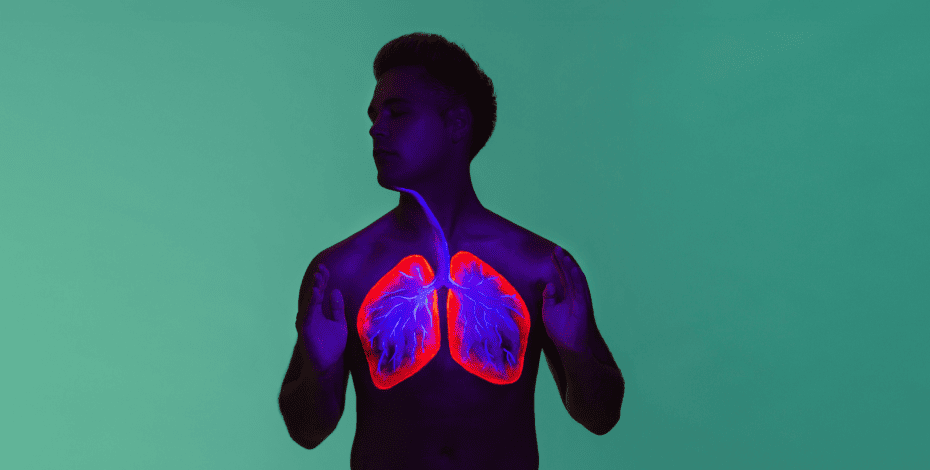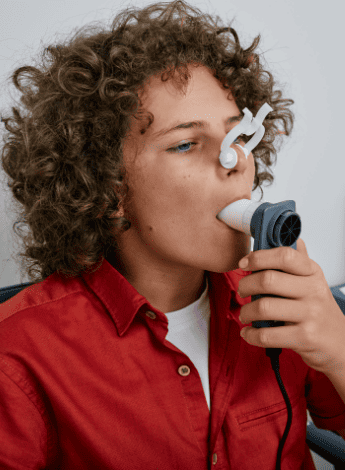
Five facts about lung function

Dr Sonia Cheng, chair of the APA Cardiorespiratory national group, and Dr Lisa Pagano highlight the importance of measuring lung function in primary care and the role of physiotherapy in performing spirometry and interpreting spirometry results.
1 Electronic desktop spirometers should be used in primary care

Chronic obstructive pulmonary disease (COPD) is markedly underdiagnosed in primary care, with an estimated 25–50 per cent of individuals with a clinically significant respiratory disease going undetected or being misdiagnosed (Ho et al 2019).
Spirometry, which is critical for making a definitive diagnosis of COPD and asthma, assesses lung function by measuring the volume of air that a person can expel from their lungs after a maximal inspiration.
Spirometry is also important for measuring the presence and severity of restrictive lung conditions, pre-employment and workforce screening in hazardous occupational environments and assessing fitness for surgery.
Good spirometry technique requires maximal inhalation, a good mouth seal around the spirometer mouthpiece and rapid exhalation until there is no more air left to expel.
Three readings should be obtained, two of which should be within 150 millilitres of each other.
Electronic desktop spirometers are ideal for primary care because they are portable and provide a real-time visual display to help assess the quality and repeatability of blows (GOLD Spirometry Guide 2024).
Such spirometers are expensive but require little maintenance other than calibration and cleaning.
Their accuracy can remain consistent for years.
In low-resource settings, where there is limited access to electronic desktop spirometers, handheld spirometers can be used as a substitute for screening and diagnosis of airway obstruction.
However, while handheld spirometers provide numerical values for the volumes of air expired, they cannot determine how well the test was performed.
2 When interpreting spirometry results, the lower limit of normal should be used

Spirometry provides information on:
- forced expiratory volume in one second (FEV1)—the volume of air exhaled in the first second
- forced vital capacity (FVC)—the total volume of air exhaled in one breath
- the ratio of FEV1 to FVC (FEV1/FVC) expressed as a fraction.
To interpret whether a person’s lung function is ‘normal’, record their age, sex and height so that the predicted FEV1 and FVC values can be determined.
The person’s ethnicity should also be recorded because predicted lung function values in people of Asian and Afro-Caribbean origin tend to be 10 per cent lower than their Caucasian age- and height-matched peers.
When it comes to interpreting the output, FEV1/FVC values below 0.7 indicate airway obstruction.
In older adults, values of 0.65–0.7 may be normal due to age-related changes affecting the lungs, thoracic cage and respiratory muscles.
Using a cut-off of 0.7 may inadvertently result in overdiagnosis of airway obstruction in older adults.
Conversely, in people younger than 45 years, using a cut-off of 0.7 may result in underdiagnosis of airway obstruction.
To avoid both issues, guidelines recommend using the lower limit of normal for adults and older adults to determine ‘normal’ lung function.
Predicted values for FEV1 and FVC can be obtained from free online resources such as the Global Lung Function Initiative calculator for spirometry.
3 Spirometry infection control measures reduce the risk of disease transmission

Spirometry is an aerosol-generating procedure with the potential to transmit airborne and bloodborne pathogens.
The Thoracic Society of Australia and New Zealand recommends delaying testing in people with a known or suspected respiratory infection, including influenza and COVID-19 (TSANZ 2022).
Other strategies to reduce the risk of cross-contamination include the use of inline viral/bacterial filters for all spirometers, wearing N95/ P2 respirators and eyewear (face shield or goggles) during testing, performing spirometry in a well-ventilated single room, handwashing before and after testing, and cleaning and disinfecting equipment and surfaces between patients.
In the absence of adequate ventilation, guidelines recommend leaving the room unoccupied between tests or using HEPA filtration systems to supplement room ventilation.
Individuals should be encouraged to bring their own short-acting bronchodilator inhaler and spacer for spirometry testing where possible.
4 Physiotherapists play a role in COPD diagnosis in primary care

There are several barriers to conducting spirometry in primary care.
Many healthcare providers lack expertise in performing or interpreting spirometry and may feel apprehensive about purchasing a spirometer because of uncertainties about its usefulness.
There is promising evidence, however, that physiotherapists can effectively conduct spirometry and accurately interpret the level of airway obstruction.
This means there is a role for physiotherapists in screening at-risk populations for COPD in primary care settings.
Of the spirometry tests performed across six GP practices in metropolitan Sydney, 83 per cent of tests conducted by physiotherapists were of acceptable quality (Pagano et al 2023).
GPs and practice nurses expressed confidence in physiotherapists’ interpretations of spirometry testing and saw the value of having a physiotherapist assist with an accurate diagnosis of COPD, which
subsequently informed their management of patients (Pagano et al 2024).
Increasing the involvement of physiotherapists in screening for airway obstruction in primary care may also facilitate early intervention for people with COPD—including timely referrals to pulmonary rehabilitation.
5 Questionnaires help identify who would benefit from spirometry in primary care

The COPD Diagnostic Questionnaire (CDQ) is a simple, low-cost tool for identifying who may benefit from spirometry testing in adults aged 40 and over with a history of smoking but no prior respiratory diagnosis.
The CDQ has demonstrated high sensitivity, ranging from 55 to 94 per cent, and low specificity, ranging from 24 to 78 per cent.
This indicates that the questionnaire can accurately identify individuals who have airway obstruction but there are a high number of false positives.
In an Australian primary care study, the CDQ had a sensitivity of 81 per cent and a specificity of 36 per cent, with an overall diagnostic accuracy of COPD 50 per cent of the time (Pagano et al 2022).
This suggests that when using the CDQ, a high proportion of individuals may be inappropriately flagged for spirometry testing when they do not have COPD.
Individuals scoring less than or equal to 16.5 points on the CDQ may be the most appropriate for further spirometry while reducing the need for unnecessary testing on all patients.
>> Dr Sonia Cheng APAM is an early career researcher and lecturer in physiotherapy at the University of Sydney. Sonia has cardiorespiratory physiotherapy experience across the spectrum of care of medical and surgical patients and has worked at Macquarie University Hospital, Royal Prince Alfred Hospital and Westmead Hospital.
>> Dr Lisa Pagano is a postdoctoral research fellow at the Australian Institute of Health Innovation. Her PhD examines the implementation of an innovative GP–physiotherapist model of care for chronic obstructive pulmonary disease in primary care. Lisa is also an Ahpra-registered practising physiotherapist, specialising in paediatrics and cardiorespiratory physiotherapy.
QUICK LINKS:
COURSE OF INTEREST:
Cardiorespiratory Physiotherapy Level 1—Part A
© Copyright 2025 by Australian Physiotherapy Association. All rights reserved.





